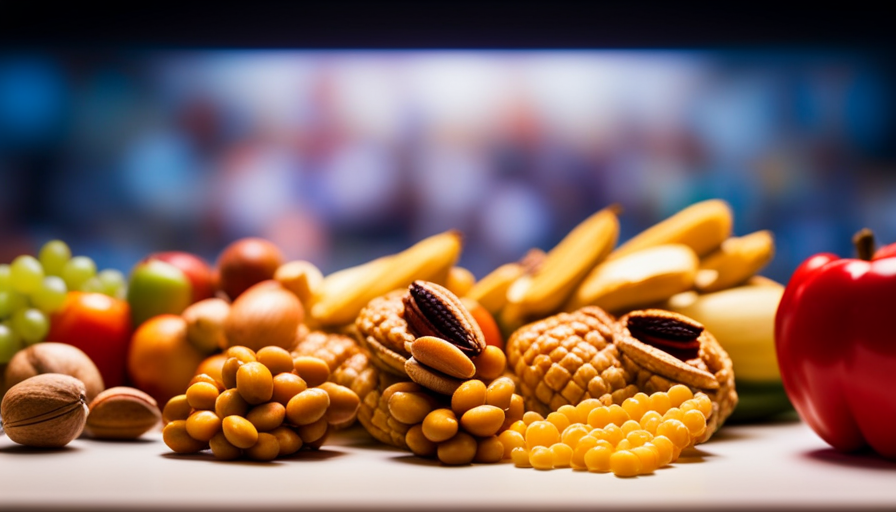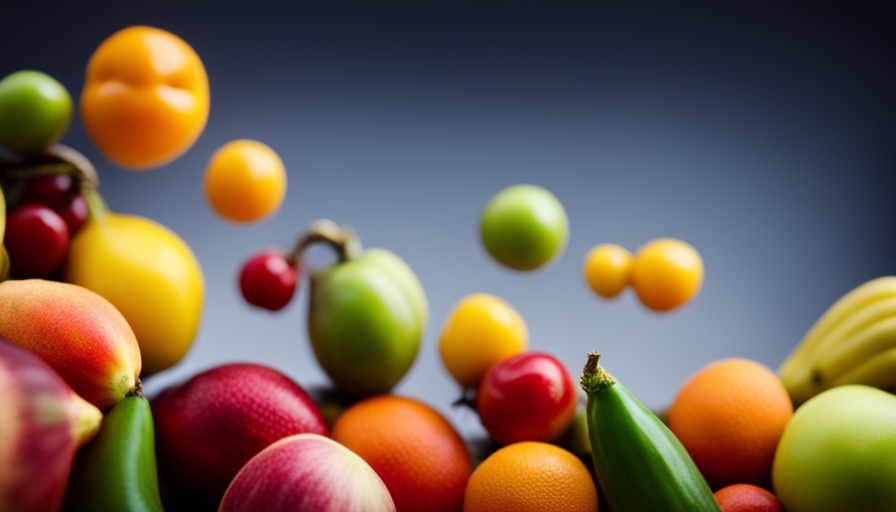Are you feeling isolated in a home filled with junk food lovers? It can be tough to stick to raw whole foods when everyone else is enjoying unhealthy snacks. But don’t worry! By staying determined and using clever tactics, you can stay focused on nurturing your body with the nutritious goodness it needs.
Just like a skilled tightrope walker gracefully balances on a thin wire, you too can navigate the delicate balance between your health goals and the temptations lurking in your pantry. In this article, we will provide you with practical tips on how to eat raw whole foods, even in a household filled with junk food.
From stocking your pantry with healthy options to managing cravings and incorporating exercise into your routine, we’ve got you covered. So put on your superhero cape and get ready to conquer your healthy eating goals, regardless of what’s lurking in your kitchen.
Key Takeaways
- Determination and smart strategies are necessary to stay on track with a raw whole foods diet.
- Setting clear goals and priorities is important for incorporating raw whole foods into your diet.
- Stocking your pantry with healthy options like fresh fruits, vegetables, nuts, seeds, whole grains, and healthy condiments is essential.
- Communicating with household members about your goals and expectations is important for creating a supportive environment.
Setting Clear Goals and Priorities
When setting clear goals and priorities, it’s important to establish a plan for incorporating raw whole foods into your diet, especially when everyone else in the house prefers junk food. To successfully navigate this challenge, it’s crucial to set boundaries and practice self-discipline.
Firstly, it’s essential to define your goals and priorities regarding your health and nutrition. Determine why you want to incorporate more raw whole foods into your diet and how it aligns with your overall well-being. This will provide you with a clear sense of purpose and motivation.
Next, set boundaries with your household members. Communicate your intentions and explain why it’s important for you to have access to raw whole foods. Ask for their support and understanding in maintaining your dietary choices. Establishing these boundaries will help create a supportive environment.
Self-discipline is key in achieving your goals. Practice mindful eating and avoid temptation. Stock your kitchen with a variety of raw whole foods that you enjoy. Plan and prepare your meals in advance to avoid impulsive unhealthy choices. Having healthy snacks readily available can also help curb cravings.
Remember, it’s important to be flexible and forgiving with yourself. Occasional indulgences are part of a balanced lifestyle. Stay focused on your goals, practice self-discipline, and you will succeed in incorporating raw whole foods into your diet, even when surrounded by junk food.
Stocking Your Pantry with Healthy Options
By filling your pantry with nourishing alternatives, you can create a haven of wholesome choices amidst the tempting sea of indulgence. Here are four essential items to stock in your pantry to help you maintain a raw whole foods diet while living with others who prefer junk food:
-
Fresh fruits and vegetables: Always have a variety of fresh produce on hand. These can be the foundation of your meals and snacks. Keep a mix of colorful fruits like berries, apples, and oranges, as well as vegetables like carrots, cucumbers, and bell peppers.
-
Nuts and seeds: These’re great sources of healthy fats, protein, and fiber. Stock up on almonds, walnuts, chia seeds, and flaxseeds. They can be enjoyed as a snack or added to salads, smoothies, or oatmeal for an extra nutritional boost.
-
Whole grains: Choose whole grains like quinoa, brown rice, and oats to provide you with sustained energy throughout the day. These can be used as a base for meals or in recipes like homemade granola bars or energy balls.
-
Healthy condiments and spices: Spice up your meals with herbs, spices, and condiments like turmeric, cinnamon, garlic powder, and apple cider vinegar. These can add flavor and provide additional health benefits.
In addition to stocking your pantry, meal prepping’s key to staying on track. Plan and prepare your meals and snacks in advance, so you always have something healthy to grab when you’re hungry. With these strategies, you can navigate the challenges of living with junk food lovers while still nourishing your body with raw whole foods.
Meal Planning and Prepping
Make your life easier and your healthy choices effortless by incorporating meal planning and prepping into your routine, so you always have nourishing options readily available. Meal prepping is a fantastic way to ensure that you have raw whole foods on hand, even when everyone else in the house is indulging in junk food. By dedicating a specific time to prepare your meals for the week, you can save time and make healthier choices.
Start by planning your meals for the week ahead. Look for recipes that incorporate raw whole foods and make a grocery list based on those ingredients. When you go grocery shopping, stick to the outer aisles where the fresh produce, lean proteins, and whole grains are usually located. Avoid the inner aisles where most of the processed and unhealthy foods are displayed.
Once you have your groceries, set aside a few hours to meal prep. Wash and chop fruits and vegetables, cook proteins, and portion out your meals into individual containers. This way, when you’re hungry and tempted to reach for junk food, you have a healthy, ready-to-eat option already prepared.
Meal planning and prepping is a powerful tool in helping you stick to your raw whole foods diet, even when everyone else in the house is eating junk food. It takes some initial effort, but the convenience and health benefits are well worth it.
Communicating with Your Household
Effectively communicating with your household members can foster a supportive environment for maintaining a healthy lifestyle. When it comes to eating raw whole foods while others in your house indulge in junk food, setting boundaries and open lines of communication are essential.
Start by having an open and honest conversation with your household members about your goals and why you’ve chosen to eat raw whole foods. Explain the benefits and how it aligns with your values and overall well-being. Encourage them to ask questions and express their concerns, and be prepared to address any misconceptions they may have.
Setting boundaries is crucial in maintaining your commitment to raw whole foods. Clearly communicate your expectations regarding the food in the house. Ask your household members to respect your choices and refrain from bringing junk food into the home. Offer alternative options that everyone can enjoy, such as fresh fruits, vegetables, and homemade raw snacks.
Additionally, find ways to compromise and create a balance. Plan meals together that incorporate both raw whole foods and other options that satisfy everyone’s preferences. This way, you can still enjoy meals as a family while staying committed to your healthy eating habits.
Remember, effective communication and setting boundaries can help create a supportive and understanding environment within your household, making it easier for you to stick to your raw whole foods lifestyle.
Finding Healthy Alternatives to Junk Food
If you’re concerned about finding healthier options that still satisfy your cravings, there are plenty of nutritious alternatives to choose from. When it comes to finding healthy snacks, it’s all about planning and preparation. Meal prep ideas can help you stay on track and have wholesome options readily available.
One great alternative to junk food is fresh fruit. Fruits like apples, bananas, and berries are not only delicious but also packed with vitamins and fiber. They can satisfy your sweet tooth while providing essential nutrients.
Another option is raw vegetables. Carrot sticks, cucumber slices, and cherry tomatoes are great choices that can be enjoyed with a tasty dip like hummus or Greek yogurt.
If you’re looking for something more substantial, consider making your own trail mix. Mix together nuts, seeds, and dried fruit for a satisfying and nutritious snack. You can also make homemade granola bars using oats, nuts, and dried fruit. These bars are a great option to grab on the go.
Incorporating these healthy alternatives into your daily routine can help you resist the temptation of junk food. By planning and preparing ahead of time, you can ensure that you always have nutritious options available that’ll keep you satisfied and on track with your raw whole foods lifestyle.
Creating a Support System
Building a strong support system can be the key to staying motivated and achieving your health goals. When you’re trying to eat raw whole foods while everyone else in the house indulges in junk food, having a support system can make all the difference.
Here are some ways to create a support system that will help you stay on track:
-
Find a like-minded friend or family member who also wants to eat healthy. You can share recipes, swap tips, and keep each other accountable. Having someone who understands your goals and can relate to your challenges can be incredibly motivating.
-
Join an online community or forum where you can connect with others who are also trying to eat raw whole foods. These communities often provide support, advice, and even healthy recipe ideas.
-
Seek out local cooking classes or workshops that focus on healthy eating. This can be a great way to meet others who are interested in the same lifestyle and learn new recipes and cooking techniques.
-
Consider working with a health coach or nutritionist who specializes in raw whole foods. They can provide personalized guidance, support, and accountability to help you stay on track.
-
Lastly, don’t be afraid to ask for support from your family members or roommates. Let them know your goals and ask for their understanding and cooperation. They may be more willing to accommodate your needs if they understand how important it is to you.
By creating accountability and finding healthy recipes, you can build a support system that will help you stay motivated on your journey to eating raw whole foods. Remember, you don’t have to do it alone!
Mindful Eating Techniques
Now that you’ve established a support system to help you navigate the challenges of eating raw whole foods while living with others who indulge in junk food, it’s time to focus on mindful eating techniques and portion control strategies.
These techniques will not only help you stay on track with your healthy eating habits but also provide a foundation for long-term success.
Mindful eating is about being present in the moment and fully engaging with your food. It involves paying attention to the taste, texture, and smell of each bite, as well as the sensations in your body. By practicing mindful eating, you can develop a deeper appreciation for the nourishing qualities of whole foods and avoid mindlessly consuming junk food.
In addition to mindful eating, portion control strategies can help you maintain a balanced diet. Start by using smaller plates and bowls to visually trick your brain into thinking you have a larger portion. Chew your food slowly and savor each bite, allowing your brain to register the feeling of fullness. If you find yourself wanting seconds, wait a few minutes to see if you’re still hungry.
By incorporating these mindful eating techniques and portion control strategies into your daily routine, you can successfully navigate the temptations of junk food and stay committed to your raw whole foods journey.
Managing Cravings and Temptations
Resisting the siren call of indulgent treats can be a challenging tightrope walk, but with mindful eating techniques and portion control strategies, you can navigate the treacherous waters of cravings and temptations. One way to manage cravings is by identifying and managing emotional triggers. Many times, we turn to junk food as a way to cope with stress, sadness, or boredom. By recognizing these triggers, you can find alternative ways to address your emotions, such as going for a walk, practicing meditation, or engaging in a hobby.
In addition to managing emotional triggers, it’s important to have healthy snack options readily available. This is where planning and preparation play a crucial role. By stocking your pantry and refrigerator with raw whole foods that are easy to grab and eat, you’ll be less likely to reach for the junk food. Here are some examples of healthy snacks you can incorporate into your daily routine:
| Food | Benefits | Serving Size |
|---|---|---|
| Apple slices with almond butter | Provides fiber and healthy fats | 1 medium apple with 1 tablespoon of almond butter |
| Carrot sticks with hummus | High in vitamins and minerals | 1 medium carrot with 2 tablespoons of hummus |
| Greek yogurt with berries | Rich in protein and antioxidants | 1 cup of Greek yogurt with half a cup of berries |
| Raw nuts and seeds | Good source of healthy fats and protein | 1 ounce (about a handful) |
By incorporating these strategies and having healthy snack options available, you can successfully manage cravings and temptations, even when everyone else in the house is indulging in junk food. Remember, it’s all about balance and making conscious choices that align with your goals for eating raw whole foods.
Incorporating Exercise into Your Routine
Incorporate exercise into your routine by finding activities that you enjoy and that get your heart pumping, such as dancing, hiking, or playing a sport.
Cardio exercises are a great way to burn calories and improve your cardiovascular health. You can try activities like running, cycling, or swimming to get your heart rate up. If you prefer to stay indoors, you can also try high-intensity interval training (HIIT) workouts or aerobic exercises like jumping jacks or burpees.
In addition to cardio, it’s important to incorporate strength training into your routine. Strength training helps build muscle, which can increase your metabolism and help you burn more calories throughout the day. You don’t need a gym membership or fancy equipment to do strength training at home. You can use your own body weight for exercises like push-ups, squats, and lunges. You can also use household items like water bottles or cans as weights.
To make it easier to stick to your exercise routine, try to find a time that works best for you and make it a habit. You can schedule your workouts in advance, set reminders, or find a workout buddy to hold you accountable. Remember to start slowly and gradually increase the intensity and duration of your workouts to avoid injury. Most importantly, have fun with it! Find activities that you genuinely enjoy and look forward to, so that exercise becomes something you love rather than a chore.
Celebrating Your Successes and Staying Motivated
Finding ways to celebrate your fitness achievements and staying motivated is like fuel for the fire of your fitness journey. It’s important to acknowledge and reward yourself for the progress you’ve made. Celebrating your successes not only boosts your confidence but also helps to keep you motivated and focused on your goals.
Staying positive is key when it comes to maintaining motivation. Self-reflection is a powerful tool that can help you stay positive and focused on your fitness journey. Take a moment to reflect on how far you’ve come and all the obstacles you’ve overcome. Remind yourself of the reasons why you started this journey in the first place and how achieving your goals will improve your overall well-being.
To help you stay positive and motivated, create a self-reflection table like the one below:
| Accomplishments | Reasons for Celebrating |
|---|---|
| Ran a 5K | Improved cardiovascular endurance |
| Lost 10 pounds | Increased confidence and self-esteem |
| Completed a fitness challenge | Proved dedication and commitment |
By filling out this table, you can visually see your accomplishments and the reasons why they are worth celebrating. This can serve as a reminder of how far you’ve come and keep you motivated to continue your healthy lifestyle. Remember, staying positive and celebrating your successes are essential for long-term success on your fitness journey.
Frequently Asked Questions
How can I prevent my family members from eating my healthy food and snacks?
To prevent your family members from eating your healthy food and snacks, try implementing strategies for creating a separate storage area. Designate a specific shelf or drawer in the fridge or pantry just for your items.
Additionally, open communication is key. Talk to your family members about your dietary needs and explain why it’s important for you to have access to these foods.
By setting boundaries and having open conversations, you can help ensure that your healthy options are respected and preserved.
What are some quick and easy raw whole food recipes that I can prepare for myself?
To prepare quick and easy raw whole food recipes, start by incorporating fresh fruits and vegetables into your meals.
Blend together a smoothie with spinach, bananas, and almond milk for a nutritious breakfast.
For lunch, make a salad with mixed greens, cherry tomatoes, cucumbers, and avocado.
As a snack, enjoy sliced apples with almond butter.
To make meal prepping easier, wash and chop your produce in advance, so it’s ready to go when hunger strikes.
How do I handle social situations where junk food is served?
Handling cravings and finding healthy alternatives in social situations where junk food is served can be challenging. Did you know that a study found that people tend to eat more when they’re in a social setting?
To combat this, try filling up on nutrient-rich whole foods before going to an event. Additionally, bring your own healthy snacks to share, like cut-up veggies or fruit. Finally, remember to stay mindful of your choices and focus on enjoying the company rather than solely on the food.
Can I still enjoy occasional treats while following a raw whole food diet?
Yes, you can still enjoy occasional treats while following a raw whole food diet. The key is to choose treats that align with your diet principles. Look for raw, whole food alternatives to traditional treats, such as raw desserts or homemade energy balls made with natural ingredients. These treats can satisfy your cravings while still nourishing your body. Remember, moderation is key, so enjoy your occasional treats while staying true to your raw whole food lifestyle.
How can I resist the temptation to indulge in junk food when it’s readily available in my household?
To resist the temptation of indulging in junk food when it’s readily available, you can use the phrase ‘mind over matter.’ Remind yourself that you have control over your choices and cravings. Instead of giving in, try finding healthy alternatives that satisfy your taste buds.
Stock up on fresh fruits, vegetables, and whole grains. Prepare nutritious snacks in advance and keep them readily accessible. By focusing on your goals and making conscious choices, you can overcome the allure of junk food.
Can I Maintain a Raw Food Diet While Living with Others Who Eat Junk Food?
Maintaining a starting raw food diet while living with others who eat junk food can be challenging. It’s important to communicate your dietary choices with your housemates and find a compromise. Keep your raw food ingredients separate and focus on incorporating healthy, delicious recipes to avoid temptation.
Conclusion
Congratulations! You’ve made it to the end of the article. Now that you have all the tools and strategies to eat raw whole foods while living in a house full of junk food, you’re well-equipped to make healthier choices.
Just remember, as you resist the temptation of those tempting treats, imagine yourself as a superhero overcoming the villainous junk food. Your commitment to nourishing your body with wholesome foods will lead you on a path to better health and vitality.
So go ahead, embrace the irony and conquer those cravings. You’ve got this!










